General, Sir John Monash, Personal Files Book 20, 31 July - 15 August - 1918 - Part 17
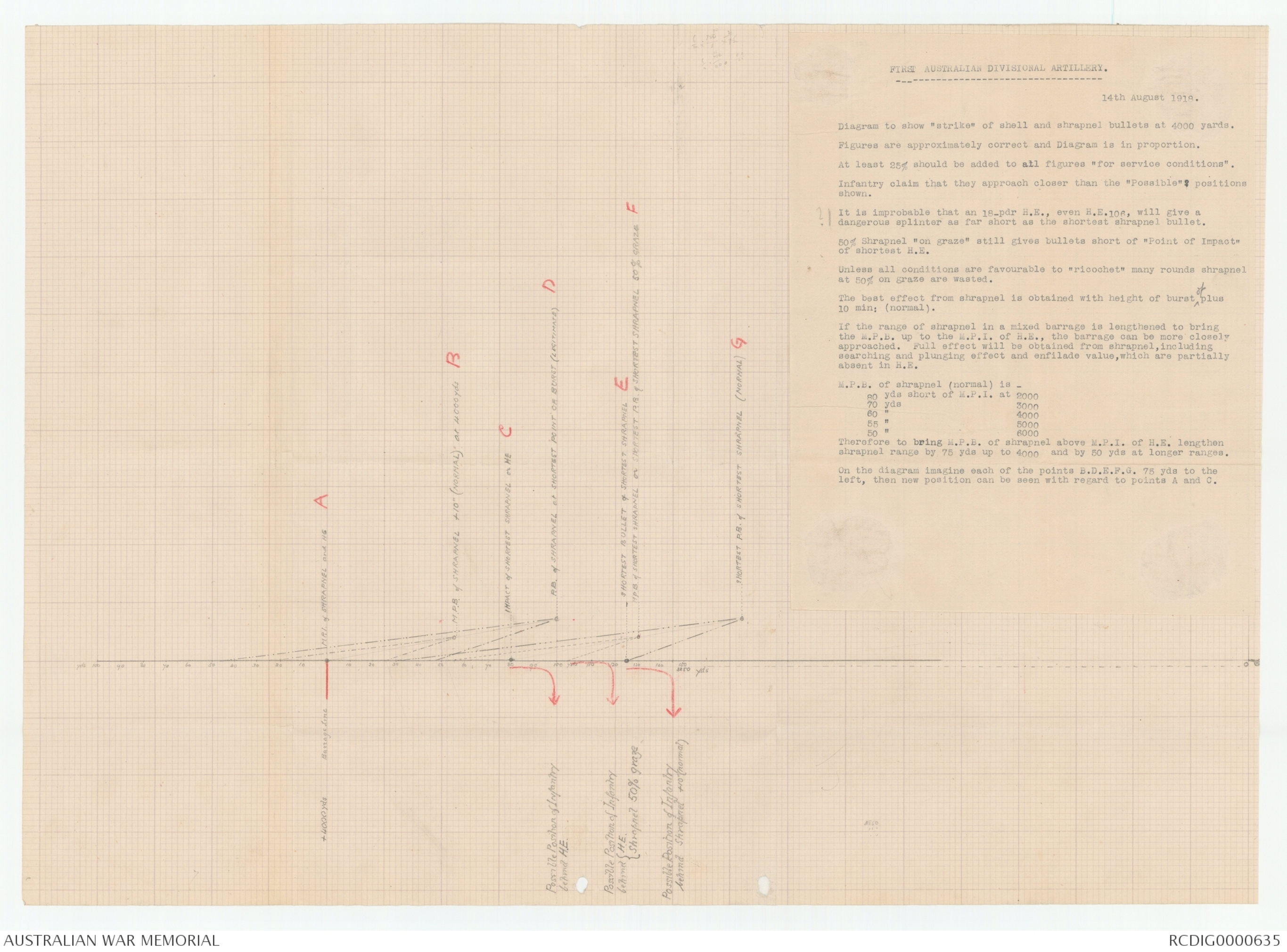
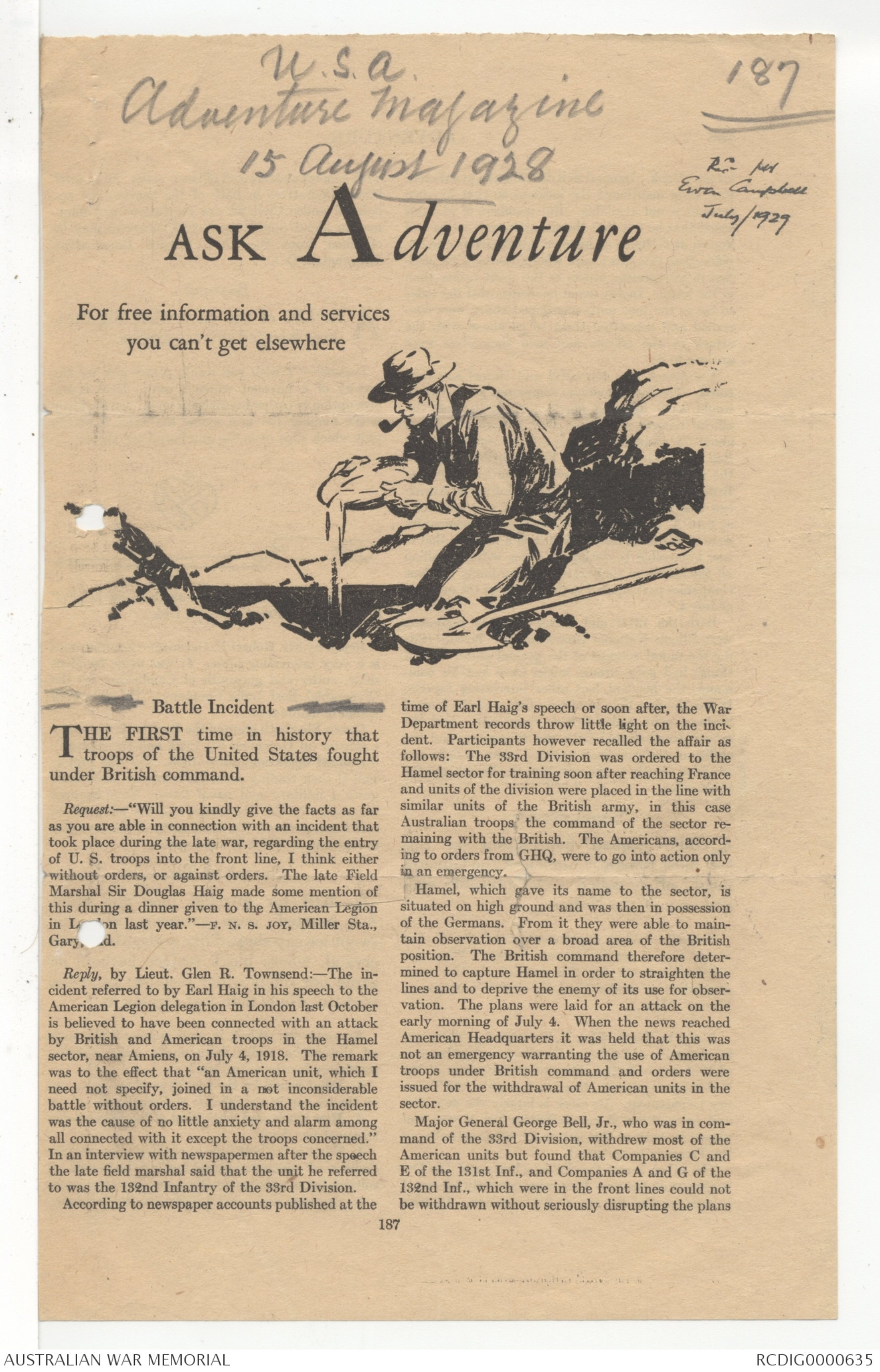
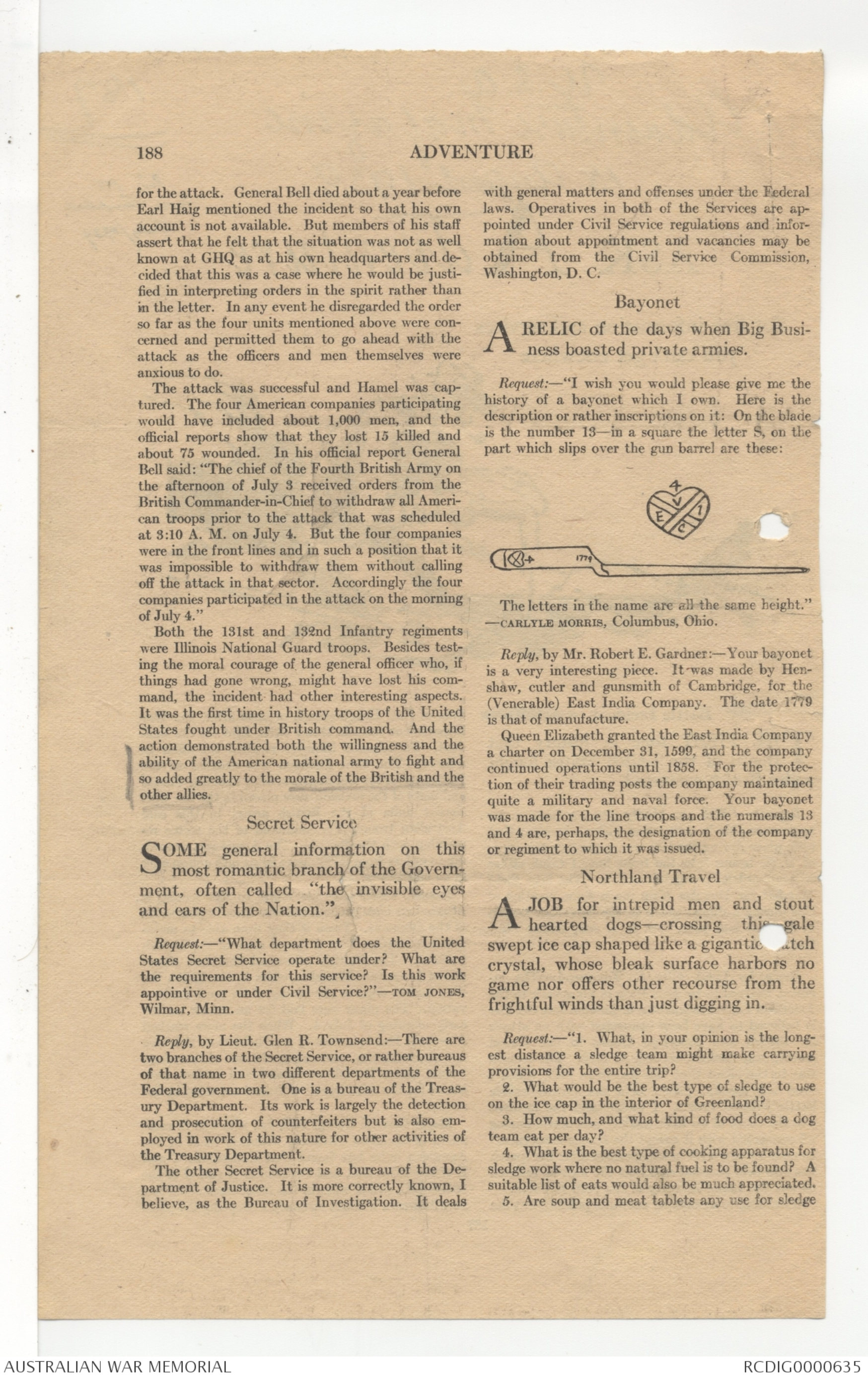
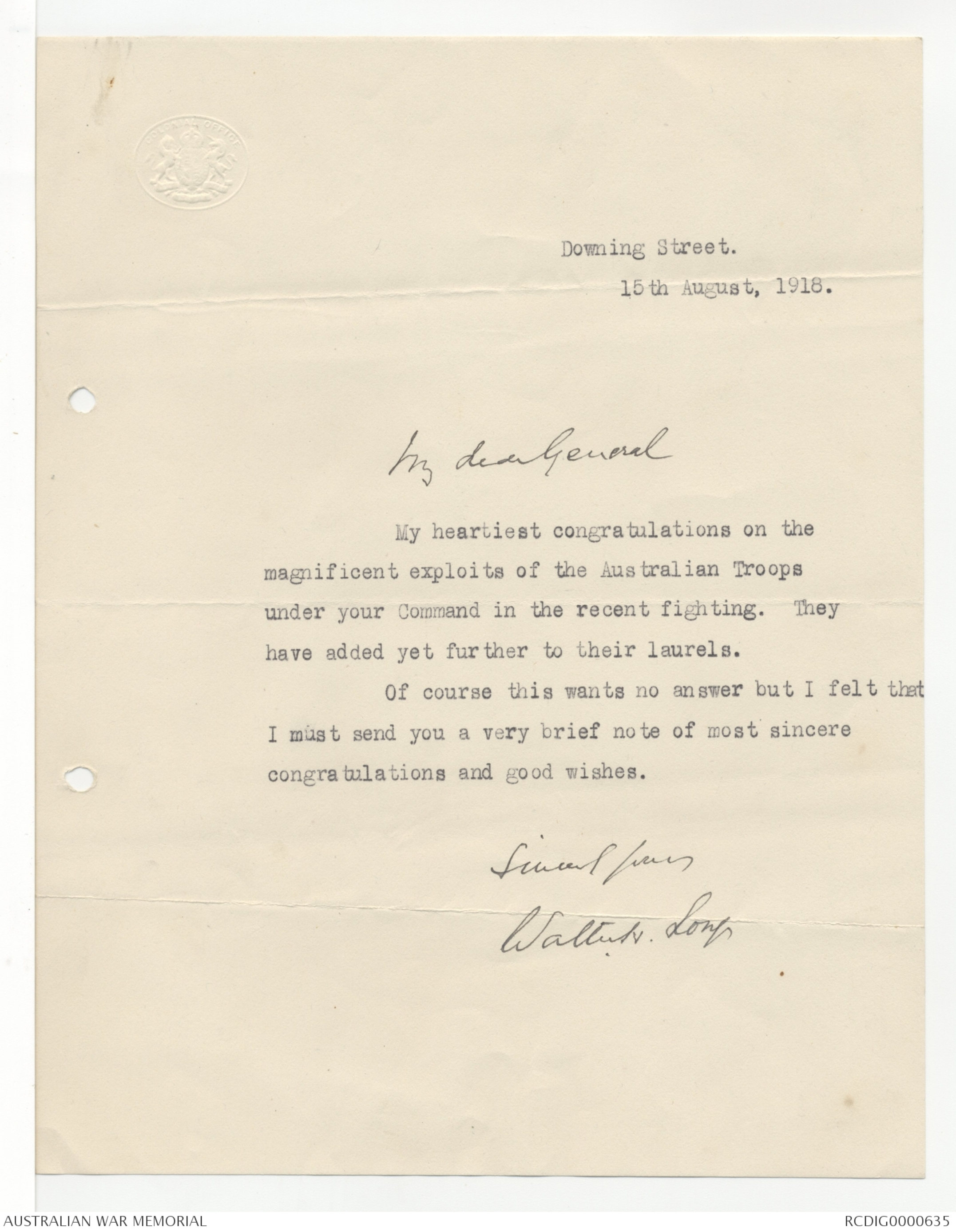
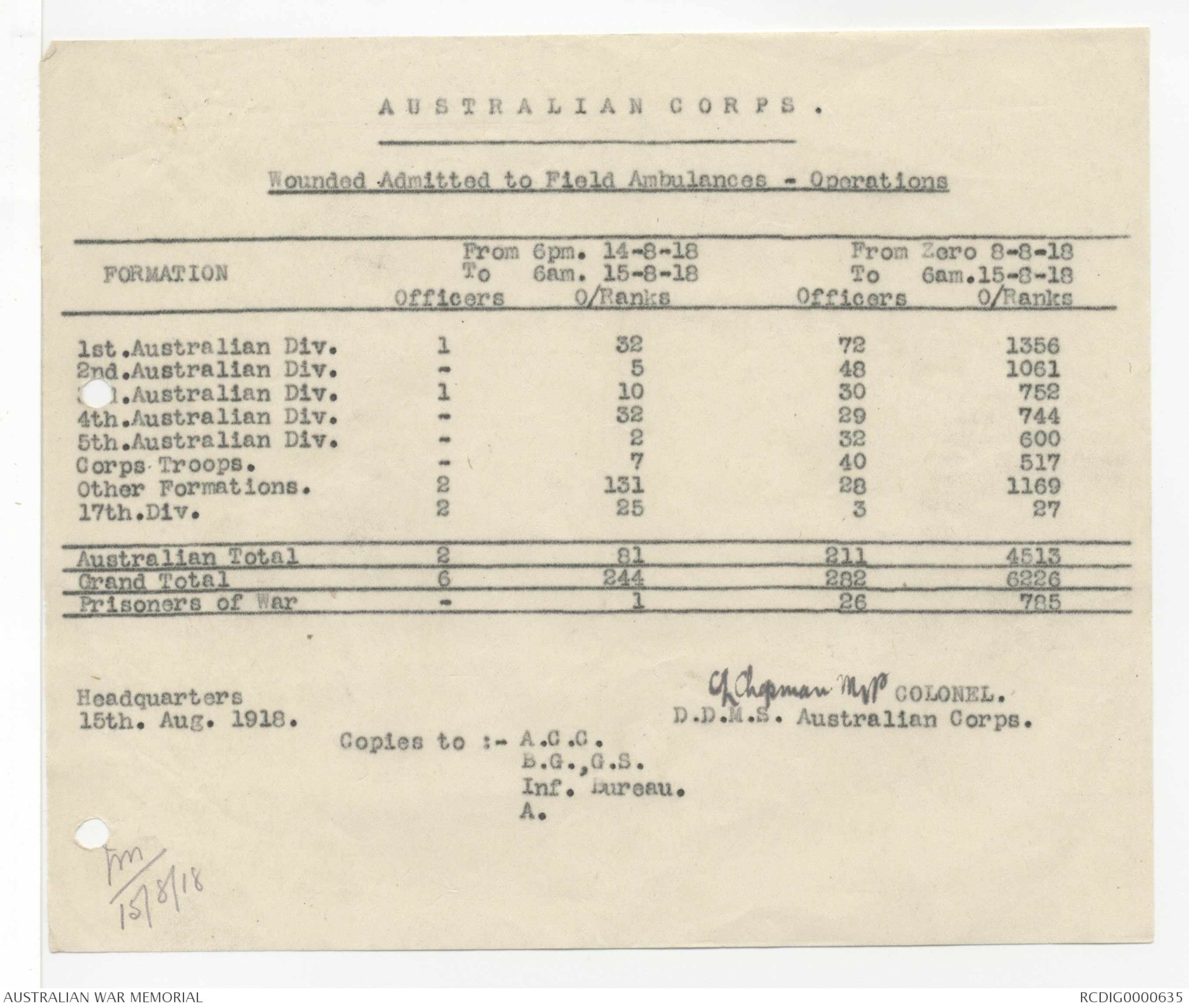
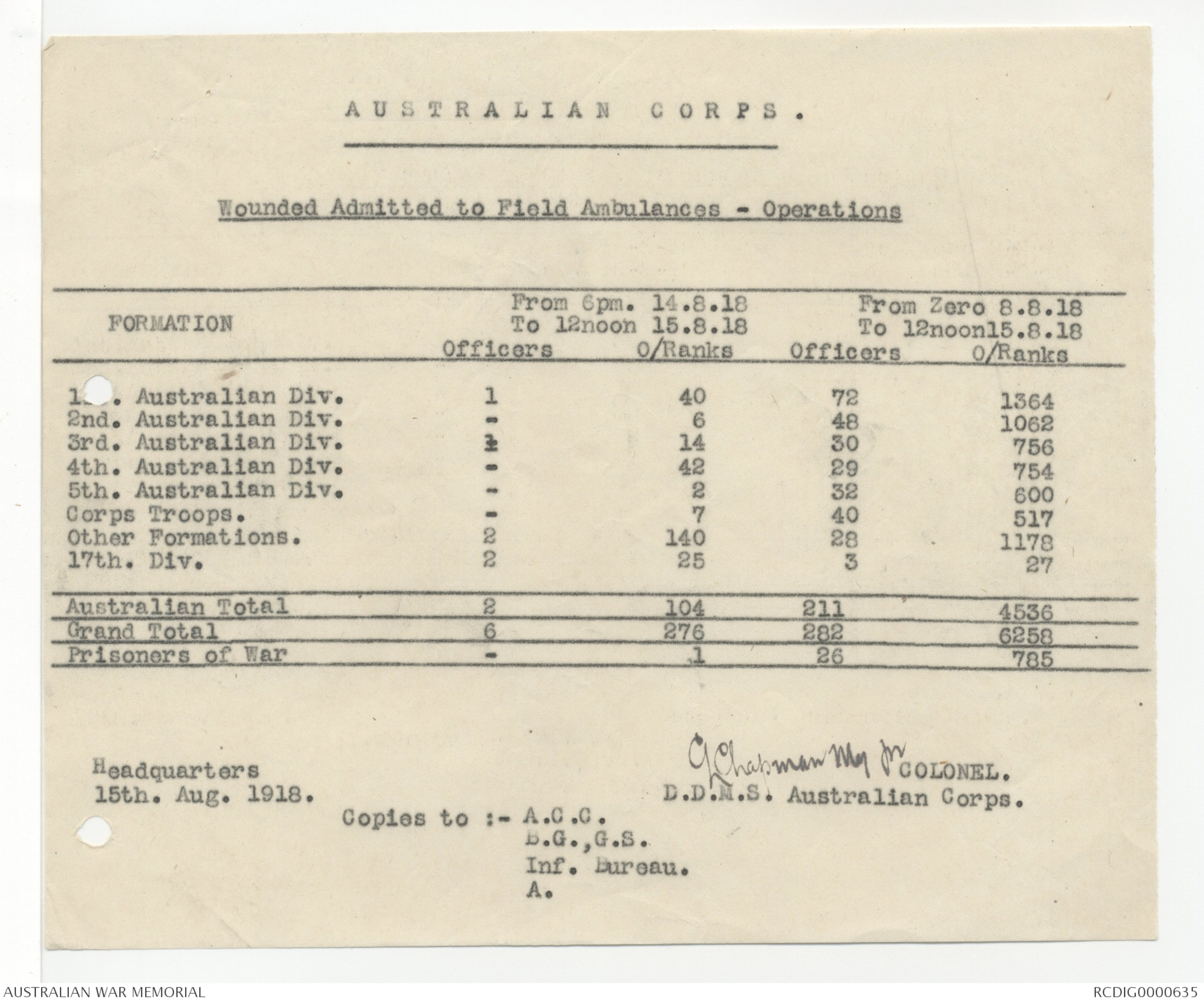
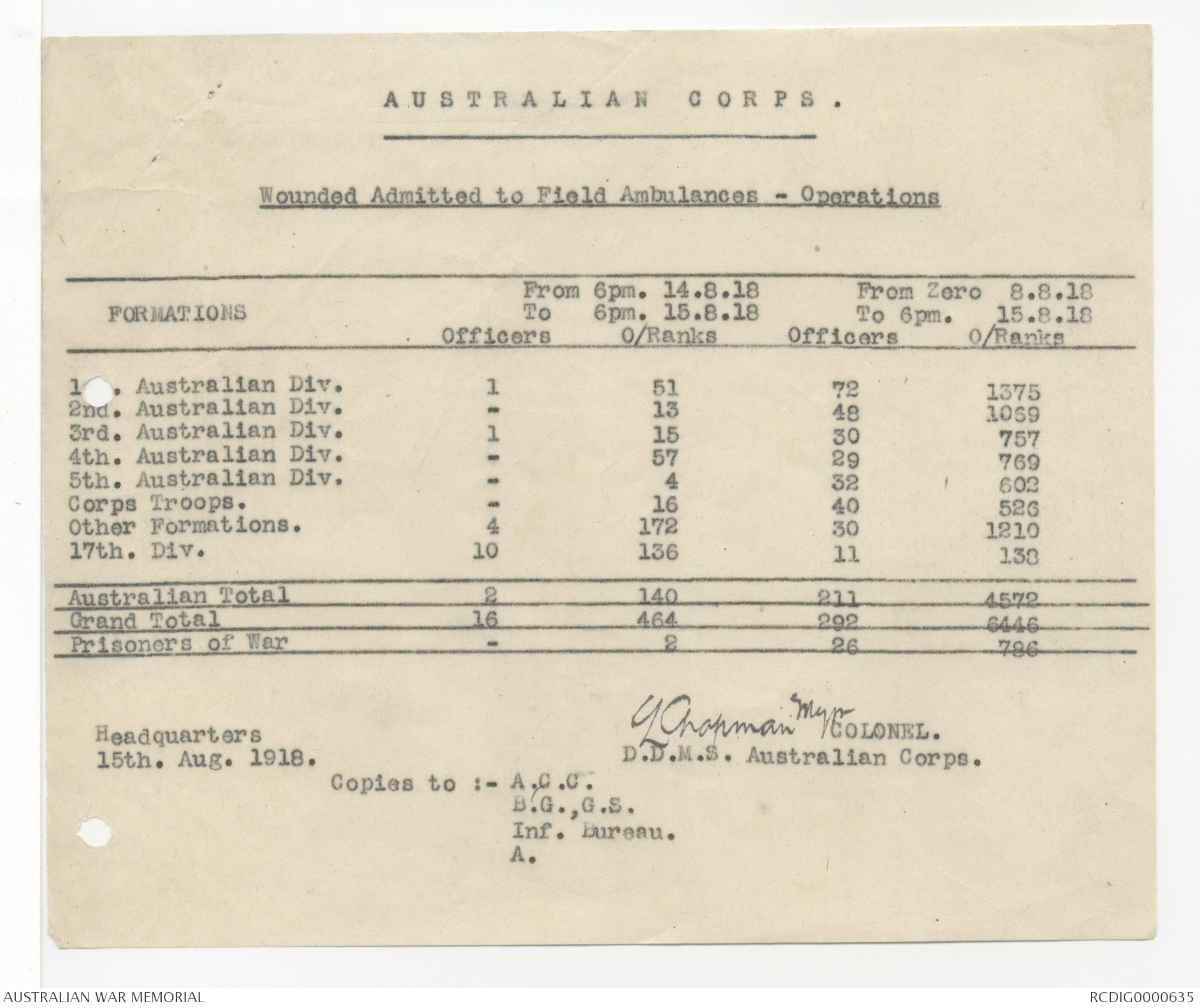
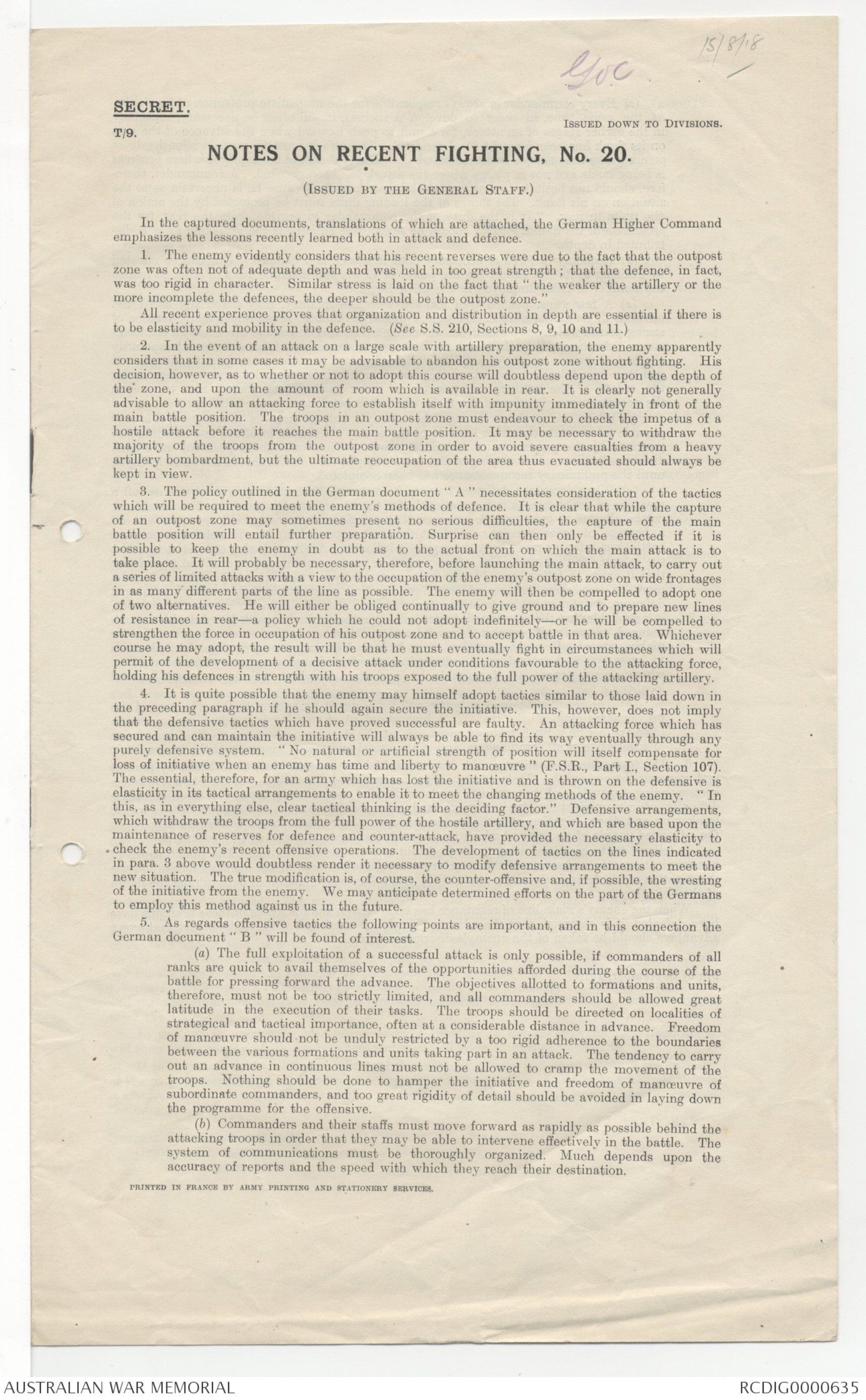
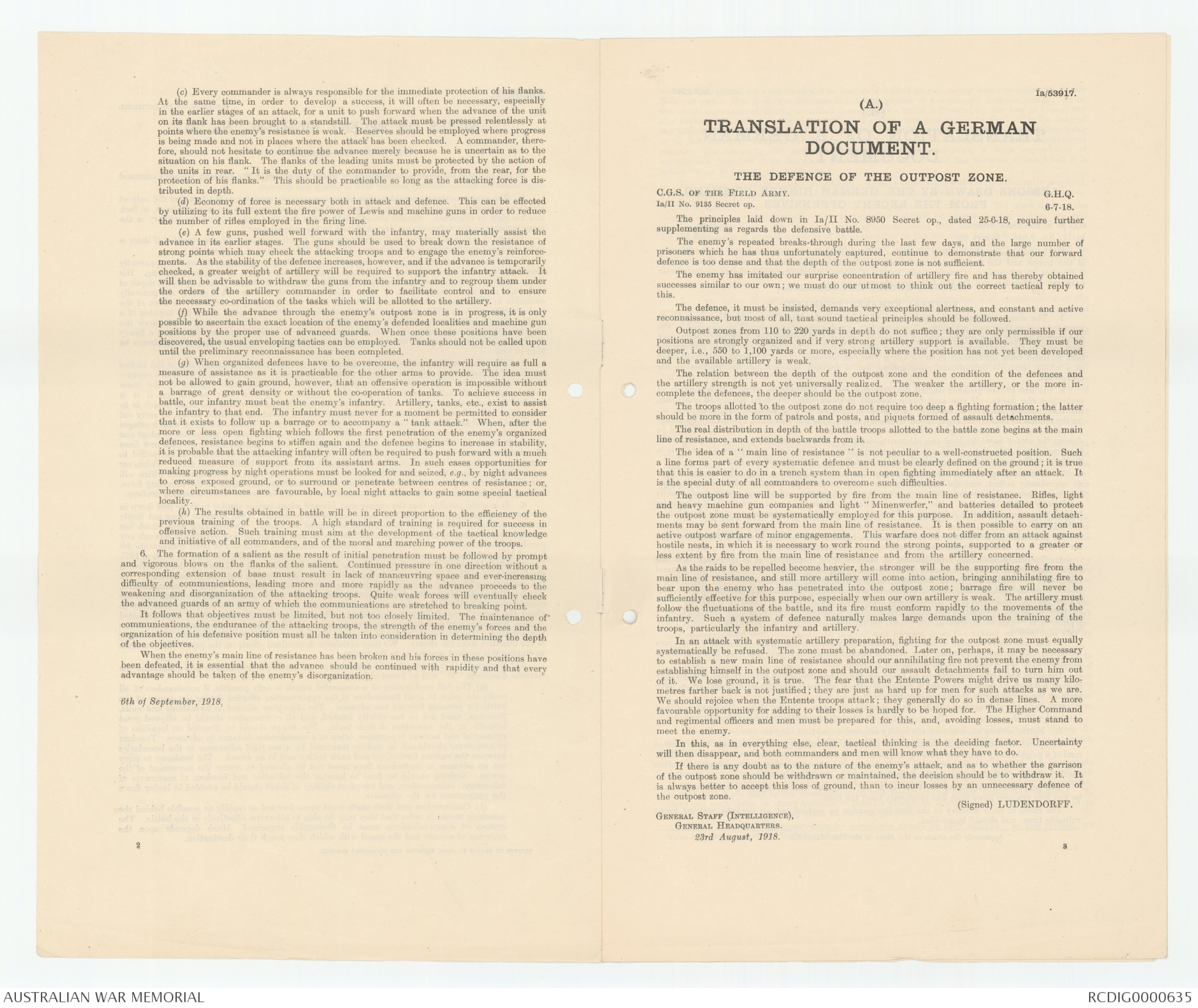
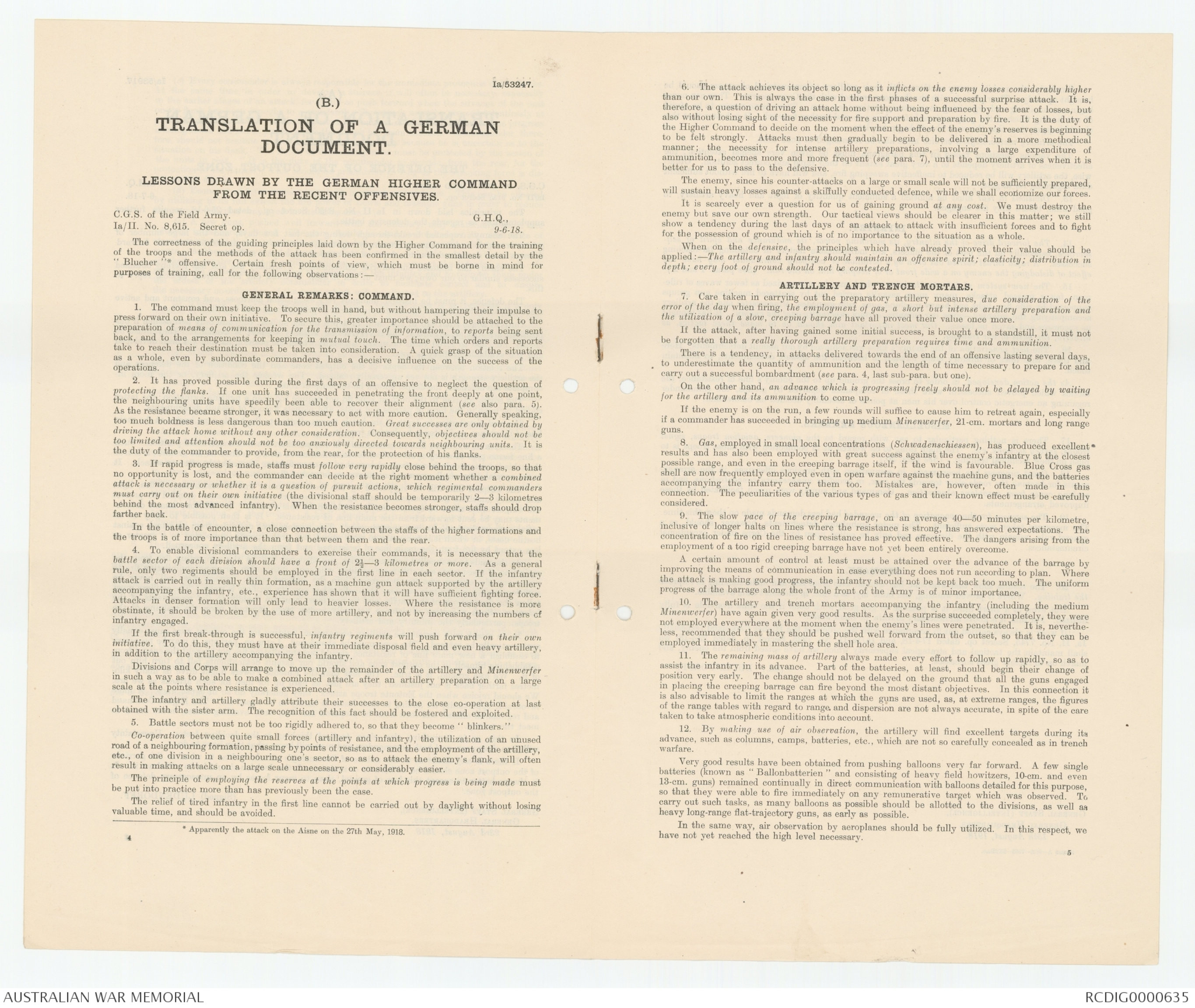
Diagram. See original
FIRST AUSTRALIAN DIVISIONAL ARTILLERY.
14th August 1918.
Diagram to show "strike" of shell and shrapnel bullets at 4000 yards.
Figures are approximately correct and Diagram is in proportion.
At least 25% should be added to all figures "for service conditions".
Infantry claim that they approach closer than the "Possible"? positions
shown.
[*?*]It is improbable that an 18_pdr H.E., even H.E.106, will give a
dangerous splinter as far short as the shortest shrapnel bullet.
50% Shrapnel "on graze" still gives bullets short of "Point of Impact"
of shortest H.E.
Unless all conditions are favourable to "ricochet" many rounds shrapnel
at 50% on graze are wasted.
The best effect from shrapnel is obtained with height of burst ∧ of plus
10min: (normal).
If the range of shrapnel in a mixed barrage is lengthened to bring
the M.P.B. up to the M.P.I. of H.E., the barrage can be more closely
approached. Full effect will be obtained from shrapnel, including
searching and plunging effect and enfilade value, which are partially
absent in H.E.
M.P.B. of shrapnel (normal) is _
80 yds short of M.P.I. at 2000
70 yds 3000
60 " 4000
55 " 5000
50 " 6000
Therefore to bring M.P.E. of shrapnel above M.P.I. of H.E. lengthen
shrapnel range by 75 yds up to 4000 and by 50 yds at longer ranges.
On the diagram imagine each of the points B.D.E.F.G. 75 yds to the
left, then new position can be seen with regard to points A and C.
[*AUSTRALIAN WAR MEMORIAL RCDIG0000635*]
Magazine page. See Original
[*U.S.A.*]
[*Adventure magazine*]
[*15 August 1928*]
[*187*]
[*Recd per*]
[*Ewan Campbell*]
[*July / 1929*]
[*AUSTRALIAN WAR MEMORIAL RCDIG0000635*]
Magazine page. See Original
[*AUSTRALIAN WAR MEMORIAL RCDIG0000635*]
Downing Street.
15th August, 1918.
My dear General
My heartiest congratulations on the
magnificent exploits of the Australian Troops
under your Command in the recent fighting. They
have added yet further to their laurels.
Of course this wants no answer but I felt that
I must send you a very brief note of most sincere
congratulations and good wishes.
Sincerl Yours
Walter Long
[*AUSTRALIAN WAR MEMORIAL RCDIG0000635*]
AUSTRALIAN CORPS.
Wounded Admitted to Field Ambulances - Operations
From 6pm. 14-8-18 From Zero 8-8-18
FORMATION To 6am. 15-8-18 To 6am. 15-8-18
Officers O/Ranks Officers O/Ranks
1st.Australian Div. 1 32 72 1356
2nd.Australian Div. - 5 48 1061
3rd.Australian Div. 1 10 30 752
4th.Australian Div. - 32 29 744
5th.Australian Div. - 2 32 600
Corps Troops. - 7 40 517
Other Formations. 2 131 28 1169
17th.Div. 2 25 3 27
Australian Total 2 81 211 4513
Grand Total 6 244 282 6226
Prisoners of War - 1 26 785
Headquarters.
15th. Aug. 1918
CL Chapman MJ COLONEL.
D.D.M.S. Australian Corps.
Copies to :- A.C.C.
B.G. ,G.S.
Inf. Bureau.
A.
[*JM*]
[*15/8/18*]
[*AUSTRALIAN WAR MEMORIAL RCDIG0000635*]
AUSTRALIAN CORPS.
Wounded Admitted to Field Ambulances - Operations
From 6pm. 14.8.18 From Zero 8.8.18
FORMATION To 12noon 15.8.18 To 12noon 15.8.18
Officers O/Ranks Officers O/Ranks
1st.Australian Div. 1 40 72 1364
2nd.Australian Div. - 6 48 1062
3rd.Australian Div. 1 14 30 756
4th.Australian Div. - 42 29 754
5th.Australian Div. - 2 32 600
Corps Troops. - 7 40 517
Other Formations. 2 140 28 1178
17th.Div. 2 25 3 27
Australian Total 2 104 211 4536
Grand Total 6 276 282 6258
Prisoners of War - 1 26 785
Headquarters.
15th. Aug. 1918
CL Chapman Mj for COLONEL.
D.D.M.S. Australian Corps.
Copies to :- A.C.C.
B.G. ,G.S.
Inf. Bureau.
A.
[*AUSTRALIAN WAR MEMORIAL RCDIG0000635*]
AUSTRALIAN CORPS.
Wounded Admitted to Field Ambulances - Operations
From 6pm. 14.8.18 From Zero 8.8.18
FORMATION To 6pm. 15.8.18 To 6pm. 15.8.18
Officers O/Ranks Officers O/Ranks
1st. Australian Div. 1 51 72 1375
2nd. Australian Div. - 13 48 1059
3rd. Australian Div. 1 15 30 757
4th. Australian Div. - 57 29 769
5th. Australian Div. - 4 32 602
Corps Troops. - 16 40 526
Other Formations. 4 172 30 1210
17th.Div. 10 136 11 138
Australian Total 2 140 211 4572
Grand Total 16 464 292 6446
Prisoners of War - 2 26 786
Headquarters.
15th. Aug. 1918
CL Chapman Mj for COLONEL.
D.D.M.S. Australian Corps.
Copies to :- A.C.C.
B.G. ,G.S.
Inf. Bureau.
A.
[*AUSTRALIAN WAR MEMORIAL RCDIG0000635*]
[*15/8/18*]
[*GOC*]
SECRET.
ISSUED DOWN TO DIVISIONS.
T/9.
NOTES ON RECENT FIGHTING, NO. 20.
(ISSUED BY THE GENERAL STAFF.)
In the captured documents, translations of which are attached, the German Higher Command
emphasizes the lessons recently learned both in attack and defence.
1. The enemy evidently considers that his recent reverses were due to the fact that the outpost
zone was often not of adequate depth and was held in too great strength; that the defence, in fact,
was too rigid in character. Similar stress is laid on the fact that "the weaker the artillery or the
more incomplete the defences, the deeper should be the outpost zone."
All recent experience proves that organization and distribution in depth are essential if there is
to be elasticity and mobility in the defence. (See S.S. 210, Sections 8, 9, 10 and 11.)
2. In the event of an attack on a large scale with artillery preparation, the enemy apparently
considers that in some cases it may be advisable to abandon his outpost zone without fighting. His
decision, however, as to whether or not to adopt this course will doubtless depend upon the depth of
the zone, and upon the amount of room which is available in rear. It is clearly. not generally
advisable to allow an attacking force to establish itself with impunity immediately in front of the
main battle position. The troops in an outpost zone must endeavour to check the impetus of a
hostile attack before it reaches the main battle position. It may be necessary to withdraw the
majority of the troops from the outpost zone in order to avoid severe casualties from a heavy
artillery bombardment, but the ultimate reoccupation of the area thus evacuated should always be
kept in view.
3. The policy outlined in the German document "A" necessitates consideration of the tactics
which will be required to meet the enemy's methods of defence. It is clear that while the capture
of an outpost zone may sometimes present no serious difficulties, the capture of the main
battle position will entail further preparation. Surprise can then only be effected if it is
possible to keep the enemy in doubt as to the actual front on which the main attack is to
take place. It will probably be necessary, therefore, before launching the main attack, to carry out
a series of limited attacks with a view to the occupation of the enemy's outpost zone on wide frontages
in as many different parts of the line as possible. The enemy will then be compelled to adopt one
of two alternatives. He will either be obliged continually to give ground and to prepare new lines
of resistance in rear - a policy which he could not adopt indefinitely - or he will be compelled to
strengthen the force in occupation of his outpost zone and accept battle in that area. Whichever
course he may adopt, the result will be that he must eventually fight in circumstances which will
permit the development of decisive attack under conditions favourable to the attacking force,
holding his defences in strength with his troops exposed to the full power of the attacking artillery.
4. It is quite possible that the enemy may himself adopt tactics similar to those laid down in
the preceding paragraph if he should again secure the initiative. This, however, does not imply
that the defensive tactics which have proved successful are faulty. An attacking force which has
secured and can maintain the initiative will always be able to find its way eventually through any
purely defensive system. "No natural or artificial strength of position will itself compensate for
loss of initiative when an enemy has time to liberty and manoeuvre" (F.S.R., Part I., Section 107).
The essential, therefore, for an army which has lost the initiative and is thrown on the defensive is
elasticity in its tactical arrangements to enable it to meet the changing methods of the enemy. "In
this, as in everything else, clear tactical thinking is the deciding factor." Defensive arrangements,
which withdraw the troops from the full power of the hostile artillery, and which are based upon the
maintenance of reserves for defence and counter-attack, have provided the necessary elasticity to
check the enemy's recent offensive operations. The development of tactics on the lines indicated
in para. 3 above would doubtless render it necessary to modify defensive arrangements to meet the
new situation. The true modification is, of course, the counter-offensive and, if possible, the wresting
of the initiative from the enemy. We may anticipate determined efforts on the part of the Germans
to employ this method against us in the future.
5. As regards offensive tactics the following points are important, and in this connection the
German document "B" will be found of interest.
(a) The full exploitation of a successful attack is only possible, if commanders of all
ranks are quick to avail themselves of the opportunities afforded during the course of the
battle for pressing forward the advance. The objectives allotted to formations and units,
therefore, must not be too strictly limited, and all commanders should be allowed great
latitude in the execution of their tasks. The troops should be directed on localities of
strategical and tactical importance, often at a considerable distance in advance. Freedom
of manoeuvre should not be unduly restricted by a too rigid adherence to the boundaries
between the various formations and units taking part in an attack. The tendency to carry
out an advance in continuous lines must not be allowed to cramp the movement of the
troops. Nothing should be done to hamper the initiative and freedom of manoeuvre of
subordinate commanders, and too great rigidity of detail should be avoided in laying down
the programme for the offensive.
(b) Commanders and their staffs must move forward as rapidly as possible behind the
attacking troops in order that they may be able to intervene effectively in the battle. The
system of communications must be thoroughly organized. Much depends upon the
accuracy of reports and the speed with which they reach their destination.
PRINTED IN FRANCE BY ARMY PRINTING AND STATIONERY SERVICES.
[*AUSTRALIAN WAR MEMORIAL RCDIG0000635*]
(c) Every commander is always responsible for the immediate protection of his flanks.
At the same time, in order to develop a success, it will often be necessary, especially
in the earlier stages of an attack, for a unit to push forward when the advance of the unit
on its flank has been brought to a standstill. The attack must be pressed relentlessly at
points where the enemy's resistance is weak. Reserves should be employed where progress
is being made and not in places where the attack has been checked. A commander, therefore,
should not hesitate to continue the advance merely because he is uncertain as to the
situation on his flank. The flanks of the leading units must be protected by the action of
the units in rear. "It is the duty of the commander to provide, from the rear, for the
protection of his flanks." This should be practicable so long as the attacking force is distributed
in depth.
(d) Economy of force is necessary both in attack and defence. This can be effected
by utilizing to its full extent the fire power of Lewis and machine guns in order to reduce
the number of rifles employed in the firing line.
(e) A few guns, pushed well forward with the infantry, may materially assist the
advance in its earlier stages. The guns should be used to break down the resistance of
strong points which may check the attacking troops and to engage the enemy's reinforcements.
As the stability of the defence increases, however, and if the advance is temporarily
checked, a greater weight of artillery will be required to support the infantry attack. It
will then be advisable to withdraw the guns from the infantry and to regroup them under
the orders of the artillery commander in order to facilitate control and to ensure
the necessary co-ordination of the tasks which will be allotted to the artillery.
(f) While the advance through the enemy's outpost zone is in progress, it is only
possible to ascertain the exact location of the enemy's defended localities and machine gun
positions by the proper use of advanced guards. When once these positions have been
discovered, the usual enveloping tactics can be employed. Tanks should not be called upon
until the preliminary reconnaissance has been completed.
(g) When organized defences have to be overcome, the infantry will require as full a
measure of assistance as it is practicable for the other arms to provide. The idea must
not be allowed to gain ground, however, that an offensive operation is impossible without
a barrage of great density or without the co-operation of tanks. To achieve success in
battle, our infantry must beat the enemy's infantry. Artillery, tanks, etc., exist to assist
the infantry to that end. The infantry must never for a moment be permitted to consider
that it exists to follow up a barrage or to accompany a " tank attack." When, after the
more or less open fighting which follows the first penetration of the enemy's organized
defences, resistance begins to stiffen again and the defence begins to increase in stability,
it is probable that the attacking infantry will often be required to push forward with a much
reduced measure of support from its assistant arms. In such cases opportunities for
making progress by night operations must be looked for and seized, e.g., by night advances
to cross exposed ground, or to surround or penetrate between centres of resistance; or,
where circumstances are favourable, by local night attacks to gain some special tactical
locality.
(h) The results obtained in battle will be in direct proportion to the efficiency of the
previous training of the troops. A high standard of training is required for success in
offensive action. Such training must aim at the development of the tactical knowledge
and initiative of all commanders, and of the moral and marching power of the troops.
6. The formation of a salient as the result of initial penetration must be followed by prompt
and vigorous blows on the flanks of the salient. Continued pressure in one direction without a
corresponding extension of base must result in lack of manœuvring space and ever-increasing
difficulty of communications, leading more and more rapidly as the advance proceeds to the
weakening and disorganization of the attacking troops. Quite weak forces will eventually check
the advanced guards of an army of which the communications are stretched to breaking point.
It follows that objectives must be limited, but not too closely limited. The maintenance of
communications, the endurance of the attacking troops, the strength of the enemy's forces and the
organization of his defensive position must all be taken into consideration in determining the depth
of the objectives.
When the enemy's main line of resistance has been broken and his forces in these positions have
been defeated, it is essential that the advance should be continued with rapidity and that every
advantage should be taken of the enemy's disorganization.
6th of September, 1918
2
[*AUSTRALIAN WAR MEMORIAL*]
Ia/53917.
(A.)
TRANSLATION OF A GERMAN
DOCUMENT.
THE DEFENCE OF THE OUTPOST ZONE.
C.G.S. OF THE FIELD ARMY. G.H.Q.
Ia/II No. 9135 Secret op. 6-7-18.
The principles laid down in Ia/ll No. 8950 Secret op., dated 25-6-18, require further
supplementing as regards the defensive battle.
The enemy's repeated breaks-through during the last few days, and the large number of
prisoners which he has thus unfortunately captured, continue to demonstrate that our forward
defence is too dense and that the depth of the outpost zone is not sufficient.
The enemy has imitated our surprise concentration of artillery fire and has thereby obtained
successes similar to our own; we must do our utmost to think out the correct tactical reply to
this.
The defence, it must be insisted, demands very exceptional alertness, and constant and active
reconnaissance, but most of all, that sound tactical principles should be followed.
Outpost zones from 110 to 220 yards in depth do not suffice; they are only permissible if our
positions are strongly organized and if very strong artillery support is available. They must be
deeper, i.e., 550 to 1,100 yards or more, especially where the position has not yet been developed
and the available artillery is weak.
The relation between the depth of the outpost zone and the condition of the defences and
the artillery strength is not yet universally realized. The weaker the artillery, or the more incomplete
the defences, the deeper should be the outpost zone.
The troops allotted to the outpost zone do not require too deep a fighting formation; the latter
should be more in the form of patrols and posts, and piquets formed of assault detachments.
The real distribution in depth of the battle troops allotted to the battle zone begins at the main
line of resistance, and extends backwards from it.
The idea of a "main line of resistance" is not peculiar to a well-constructed position. Such
a line forms part of every systematic defence and must be clearly defined on the ground; it is true
that this is easier to do in a trench system than in open fighting immediately after an attack. It
is the special duty of all commanders to overcome such difficulties.
The outpost line will be supported by fire from the main line of resistance. Rifles, light
and heavy machine gun companies and light " Minenwerfer," and batteries detailed to protect
the outpost zone must be systematically employed for this purpose. In addition, assault detachments
may be sent forward from the main line of resistance. It is then possible to carry on an
active outpost warfare of minor engagements. This warfare does not differ from an attack against
hostile nests, in which it is necessary to work round the strong points, supported to a greater or
less extent by fire from the main line of resistance and from the artillery concerned.
As the raids to be repelled become heavier, the stronger will be the supporting fire from the
main line of resistance, and still more artillery will come into action, bringing annihilating fire to
bear upon the enemy who has penetrated into the outpost zone; barrage fire will never be
sufficiently effective for this purpose, especially when our own artillery is weak. The artillery must
follow the fluctuations of the battle, and its fire must conform rapidly to the movements of the
infantry. Such a system of defence naturally makes large demands upon the training of the
troops, particularly the infantry and artillery.
In an attack with systematic artillery preparation, fighting for the outpost zone must equally
systematically be refused. The zone must be abandoned. Later on, perhaps, it may be necessary
to establish a new main line of resistance should our annihilating fire not prevent the enemy from
establishing himself in the outpost zone and should our assault detachments fail to turn him out
of it. We lose ground, it is true. The fear that the Entente Powers might drive us many kilometres
farther back is not justified; they are just as hard up for men for such attacks as we are.
We should rejoice when the Entente troops attack; they generally do so in dense lines. A more
favourable opportunity for adding to their losses is hardly to be hoped for. The Higher Command
and regimental officers and men must be prepared for this, and, avoiding losses, must stand to
meet the enemy.
In this, as in everything else, clear, tactical thinking is the deciding factor. Uncertainty
will then disappear, and both commanders and men will know what they have to do.
If there is any doubt as to the nature of the enemy's attack, and as to whether the garrison
of the outpost zone should be withdrawn or maintained, the decision should be to withdraw it. It
is always better to accept this loss of ground, than to incur losses by an unnecessary defence of the outpost zone.
(Signed) LUDENDORFF.
GENERAL STAFF (INTELLIGENCE),
GENERAL HEADQUARTERS.
23rd August, 1918
3
[*RCDIG0000635*]
Ia/53247.
(B.)
TRANSLATION OF A GERMAN
DOCUMENT.
LESSONS DRAWN BY THE GERMAN HIGHER COMMAND
FROM THE RECENT OFFENSIVES.
C.G.S. of the Field Army. G.H.Q.,
Ia/II. No. 8,615. Secret op. 9-6-18.
The correctness of the guiding principles laid down by the Higher Command for the training
of the troops and the methods of the attack has been confirmed in the smallest detail by the
"Blucher"* offensive. Certain fresh points of view, which must be borne in mind for
purposes of training, call for the following observations: —
GENERAL REMARKS: COMMAND.
1. The command must keep the troops well in hand, but without hampering their impulse to
press forward on their own initiative. To secure this, greater importance should be attached to the
preparation of means of communication for the transmission of information, to reports being sent
back, and to the arrangements for keeping in mutual touch. The time which orders and reports
take to reach their destination must be taken into consideration. A quick grasp of the situation
as a whole, even by subordinate commanders, has a decisive influence on the success of
the operations.
2. It has proved possible during the first days of an offensive to neglect the question of
protecting the flanks. If one unit has succeeded in penetrating the front deeply at one point,
the neighbouring units have speedily been able to recover their alignment (see also para. 5).
As the resistance became stronger, it was necessary to act with more caution. Generally speaking,
too much boldness is less dangerous than too much caution. Great successes are only obtained by
driving the attack home without any other consideration. Consequently, objectives should not be
too limited and attention should not be too anxiously directed towards neighbouring units. It is
the duty of the commander to provide, from the rear, for the protection of his flanks.
3. If rapid progress is made, staffs must follow very rapidly close behind the troops, so that
no opportunity is lost, and the commander can decide at the right moment whether a combined
attack is necessary or whether it is a question of pursuit actions, which regimental commanders
must carry out on their own initiative (the divisional staff should be temporarily 2-3 kilometres
behind the most advanced infantry). When the resistance becomes stronger, staffs should drop
farther back.
In the battle of encounter, a close connection between the staffs of the higher formations and
the troops is of more importance than that between them and the rear.
4. To enable divisional commanders to exercise their commands, it is necessary that the
battle sector of each division should have a front of 2½—3 kilometres or more. As a general
rule, only two regiments should be employed in the first line in each sector. If the infantry
attack is carried out in really thin formation, as a machine gun attack supported by the artillery
accompanying the infantry, etc., experience has shown that it will have sufficient fighting force.
Attacks in denser formation will only lead to heavier losses. Where the resistance is more
obstinate, it should be broken by the use of more artillery, and not by increasing the numbers of
infantry engaged.
If the first break-through is successful, infantry regiments will push forward on their own
initiative. To do this, they must have at their immediate disposal field and even heavy artillery,
in addition to the artillery accompanying the infantry.
Divisions and Corps will arrange to move up the remainder of the artillery and Minenwerfer
in such a way as to be able to make a combined attack after an artillery preparation on a large
scale at the points where resistance is experienced.
The infantry and artillery gladly attribute their successes to the close co-operation at last
obtained with the sister arm. The recognition of this fact should be fostered and exploited.
5. Battle sectors must not be too rigidly adhered to, so that they become " blinkers."
Co-operation between quite small forces (artillery and infantry), the utilization of an unused
road of a neighbouring formation, passing by points of resistance, and the employment of the artillery,
etc., of one division in a neighbouring one's sector, so as to attack the enemy's flank, will often
result in making attacks on a large scale unnecessary or considerably easier.
The principle of employing the reserves at the points at which progress is being made must
be put into practice more than has previously been the case.
The relief of tired infantry in the first line cannot be carried out by daylight without losing
valuable time, and should be avoided.
* Apparently the attack on the Aisne on the 27th May, 1918.
4
[*AUSTRALIAN WAR MEMORIAL*]
6. The attack achieves its object so long as it inflicts on the enemy losses considerably higher
than our own. This is always the case in the first phases of a successful surprise attack. It is,
therefore, a question of driving an attack home without being influenced by the fear of losses, but
also without losing sight of the necessity for fire support and preparation by fire. It is the duty of
the Higher Command to decide on the moment when the effect of the enemy's reserves is beginning
to be felt strongly. Attacks must then gradually begin to be delivered in a more methodical
manner; the necessity for intense artillery preparations, involving a large expenditure of
ammunition, becomes more and more frequent (see para. 7), until the moment arrives when it is
better for us to pass to the defensive.
The enemy, since his counter-attacks on a large or small scale will not be sufficiently prepared,
will sustain heavy losses against a skilfully conducted defence, while we shall economize our forces.
It is scarcely ever a question for us of gaining ground at any cost. We must destroy the
enemy but save our own strength. Our tactical views should be clearer in this matter; we still
show a tendency during the last days of an attack to attack with insufficient forces and to fight
for the possession of ground which is of no importance to the situation as a whole. When on the defensive, the principles which have already proved their value should be
applied:- The artillery and infantry should maintain an offensive spirit; elasticity; distribution in
depth; every foot of ground should not be contested.
ARTILLERY AND TRENCH MORTARS.
7. Care taken in carrying out the preparatory artillery measures, due consideration of the
error of the day when firing, the employment of gas, a short but intense artillery preparation and
the utilization of a slow, creeping barrage have all proved their value once more.
If the attack, after having gained some initial success, is brought to a standstill, it must not
be forgotten that a really thorough artillery preparation requires time and ammunition.
There is a tendency, in attacks delivered towards the end of an offensive lasting several days,
to underestimate the quantity of ammunition and the length of time necessary to prepare for and
carry out a successful bombardment (see para. 4, last sub-para. but one).
On the other hand, an advance which is progressing freely should not be delayed by waiting
for the artillery and its ammunition to come up.
If the enemy is on the run, a few rounds will suffice to cause him to retreat again, especially
if a commander has succeeded in bringing up medium Minenwerfer, 21-cm. mortars and long range
guns.
8. Gas, employed in small local concentrations (Schwadenschiessen), has produced excellent
results and has also been employed with great success against the enemy's infantry at the closest
possible range, and even in the creeping barrage itself, if the wind is favourable. Blue Cross gas
shell are now frequently employed even in open warfare against the machine guns, and the batteries
accompanying the infantry carry them too. Mistakes are, however, often made in this
connection. The peculiarities of the various types of gas and their known effect must be carefully
considered.
9. The slow pace of the creeping barrage, on an average 40-50 minutes per kilometre,
inclusive of longer halts on lines where the resistance is strong, has answered expectations. The
concentration of fire on the lines of resistance has proved effective. The dangers arising from the
employment of a too rigid creeping barrage have not yet been entirely overcome.
A certain amount of control at least must be attained over the advance of the barrage by
improving the means of communication in case everything does not run according to plan. Where
the attack is making good progress, the infantry should not be kept back too much. The uniform
progress of the barrage along the whole front of the Army is of minor importance.
10. The artillery and trench mortars accompanying the infantry (including the medium
Minenwerfer) have again given very good results. As the surprise succeeded completely, they were
not employed everywhere at the moment when the enemy's lines were penetrated. It is, nevertheless,
recommended that they should be pushed well forward from the outset, so that they can be
employed immediately in mastering the shell hole area.
11. The remaining mass of artillery always made every effort to follow up rapidly, so as to
assist the infantry in its advance. Part of the batteries, at least, should begin their change of
position very early. The change should not be delayed on the ground that all the guns engaged
in placing the creeping barrage can fire beyond the most distant objectives. In this connection it
is also advisable to limit the ranges at which the guns are used, as, at extreme ranges, the figures
of the range tables with regard to range, and dispersion are not always accurate, in spite of the care
taken to take atmospheric conditions into account.
12. By making use of air observation, the artillery will find excellent targets during its
advance, such as columns, camps, batteries, etc., which are not so carefully concealed as in trench warfare.
Very good results have been obtained from pushing balloons very far forward. A few single
batteries (known as "Ballonbatterien" and consisting of heavy field howitzers, 10-cm. and even
13-cm. guns) remained continually in direct communication with balloons detailed for this purpose,
so that they were able to fire immediately on any remunerative target which was observed. To
carry out such tasks, as many balloons as possible should be allotted to the divisions, as well as
heavy long-range flat-trajectory guns, as early as possible.
In the same way, air observation by aeroplanes should be fully utilized. In this respect, we
have not yet reached the high level necessary.
5
[*RCDIG0000635*]
 Sam scott
Sam scottThis transcription item is now locked to you for editing. To release the lock either Save your changes or Cancel.
This lock will be automatically released after 60 minutes of inactivity.